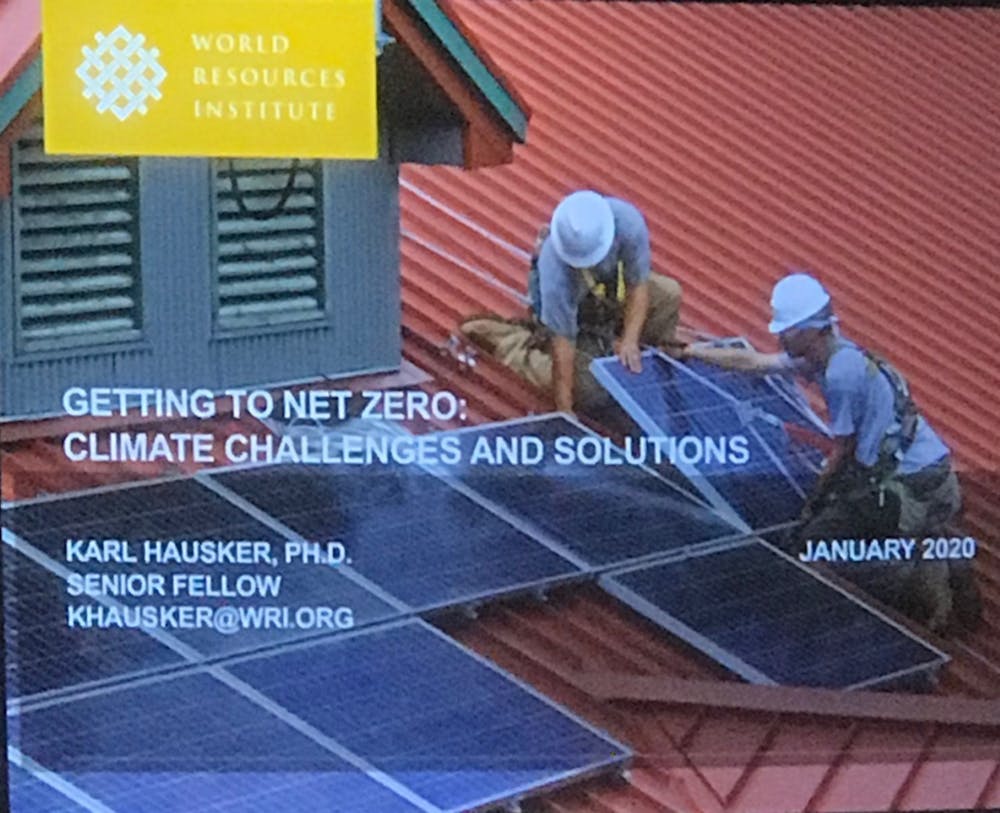On Jan. 28, the Department of Health and Engineering at Hopkins hosted Karl Hausker, who is a senior fellow at the World Resources Institute’s Climate Program. His talk, titled “Getting to Net-Zero: Climate Challenges and Solutions,” was part of the M. Gordon Wolman Seminar Series.
Throughout his lecture, he introduced the net-zero by 2050 plan and explained that a complete transition to the use of renewable sources of energy would not be enough to reach that goal.
“Some models relying heavily on the use of natural resources assume not only energy efficiency and decarbonization but also a lot of lifestyle changes that would dramatically decrease energy consumption. They assume a drop in birth rates and changes in diet which cannot be counted on,” Hausker said.
Without any changes, global warming could have devastating effects by mid-century.
Scientists from the Intergovernmental Panel on Climate Change predict that by the year 2050, the global temperature will be 1.5 degrees Celsius higher than pre-industrial levels. Such a rapid change could cause the death of many plants and animals of both land and sea that would not be able to adjust rapidly enough to the changing environment.
Furthermore, human lives would be greatly affected by the resulting risks to health, food security, water supply and economic growth. The proposed solution to this is to set a goal of zero carbon emissions worldwide by the year 2050.
Since the Paris Agreement in 2015, countries around the world have expressed their commitment to reducing greenhouse gas emissions.
The plan expected to be most successful in minimizing the effects and progression of global warming is the net-zero plan by 2050. The year 2050 has been chosen as the deadline because this will allow for warming to be limited to 1.5 degrees Celsius. Otherwise, the next best deadline is 2070 since it is expected that this would limit warming to 2 degrees Celsius.
The year 2050 is preferred due to less negative effects being predicted alongside a global temperature change of 1.5 degrees Celsius than 2 degrees Celsius. This plan would require drastic changes around the world in the next few decades to decrease the use of fossil fuels and other sources of emissions.
Countries around the globe recognize climate change as a pressing issue and have begun plans to reduce their net carbon emissions to zero by 2050. According to The New York Times, more than 60 countries within the United Nations have committed to achieving this goal, with some of them codifying this goal into law.
The list was mostly made up of countries that already have small carbon footprints. Three of the largest carbon emitters — China, the United States and India — were notably absent from the list. However, states in the U.S. such as California and New York have set the net-zero goal and research is being done to determine the best approach to get the whole world to that goal. In spite of the current situation, countries around the globe are approaching the net-zero goal by 2050 optimistically.
Currently, one of the largest contributors to the emission of greenhouse gases is industry. According to Forbes, the United States industry sector is responsible for 35 percent of greenhouse gas emissions in the country. If policies remain unchanged, this number is expected to continue to rise.
It is expected that over the next decades, most fossil fuel use will be replaced by electricity and alternative sources of energy, which will include solar and wind energy backed up by nuclear energy and biofuels. However, the transition to these forms of energy will be a long and costly process, and it is uncertain whether this alone would get the world to net-zero by 2050.
Hausker advocated for the research and use of carbon capture methods.
“We are going to need technological means of pulling carbon dioxide out of the atmosphere. I think it is near certain that we would need carbon capture to reduce industrial emissions,” he said.
Hausker went on to explain his thoughts on physical and moral hazards.
“I would rather have a concrete way of reducing the real, physical hazard of overshooting safe concentrations than the idea of a moral hazard of that technology slowing us down in reducing emissions,” he said.
The most widely known way to remove carbon dioxide emissions from the atmosphere is through the use of plants, which do this naturally.
Tree-planting and forest conservation will become a key part of this but will perhaps need to be assisted by newly developed forms of carbon capture.
One such form is the production of bioenergy through the use of energy crops, which absorb carbon as they grow.
Then, the crops would be burned and the carbon would be captured and stored underground. However, this would require large amounts of land and compete with the growing of crops for food.
A second option is direct air capture, which would segregate carbon dioxide from the air. However, this method is currently in the early stages of development.
Hausker ended his lecture by sharing hopes for the future as the world struggles with the seaarch for solutions to climate change.
“I would rather see us spread our chips over all clean technologies, make sure we bring them all to commercialization,” he said. “Whatever we do, we must build a big transmission system and consider what energy sources will work best for each country around the world.”





